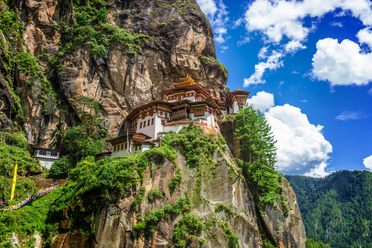Ingredients & Condiments
Bhutanese Red Rice
At 8,000 feet above sea level, glacial irrigation produces a unique heirloom grain.
A 1,000-year-old glacier supplies Bhutan’s valleys with water rich in minerals. Nestled in the Himalayas between India and Tibet, this remote, high-altitude farmland creates the only set of conditions where Bhutanese red rice thrives.
Locals revere red rice for more than its ruddy tint. With a nutty, earthy flavor and delicate texture, the heirloom grain is considered premium and precious. Farmers in the western-central regions of Paro, Punakha, and Wangdue Phodrang have cultivated this regional crop for centuries. Bhutanese hosts often offer guests a roasted red rice snack called zow, which is buttery, sweet, and crunchy.
Growers plant red rice primarily for subsistence—somewhere between 1 percent and 15 percent of the yield is said to be available commercially. Farmers work manually, without chemicals or pesticides, then semi-mill the mature grains to retain some of the colorful, nutty husk. The finished product ranges from pink to red, depending on the variety and amount of remaining husk.
Today, around 200 producers operating on small family farms keep the country’s red rice tradition alive. Decreased production stems from the accessibility of cheaper alternatives, such as white rice imported from India. Urbanization has also reduced the availability of farmland and viability of agriculture jobs, as younger generations are more inclined to seek employment in cities. Because red rice has become increasingly rare and pricey, families serve it during celebrations or as part of a holiday feast.
Where to Try It
-
Thimphu’s Weekend Market
Chhogyal Lam, Thimphu, BhutanThis outdoor market features Bhutanese chiles, cheese, red rice, and plenty of other local specialties.
-
This Woodside spot is known for its billiard tables and Bhutanese cuisine.
Written By
 rachelrummel
rachelrummel
Sources
- unctad.org/fr/pages/newsdetails.aspx?OriginalVersionID=1406
- www.fondazioneslowfood.com/en/ark-of-taste-slow-food/bhutanese-red-rice/
- www.npr.org/2012/04/17/150723012/rice-a-rainbow-of-possibilities
- www.compassandfork.com/recipe/what-is-red-rice-why-famous-food-bhutan/
- mythsandmountains.com/2015/01/6-must-taste-foods-of-bhutan/
- books.google.com/books?id=yStHDwAAQBAJ&pg=PT139&dq=rice+glacier+bhutan&hl=en&sa=X&ved=0ahUKEwiZvdCzmaviAhUPtlkKHQ8XCx4Q6AEIKDAA#v=onepage&q=rice%20glacier%20bhutan&f=false
- books.google.com/books?id=HHCCDwAAQBAJ&pg=PT74&dq=rice+glacier+bhutan&hl=en&sa=X&ved=0ahUKEwiZvdCzmaviAhUPtlkKHQ8XCx4Q6AEIOzAD#v=onepage&q=rice%20glacier%20bhutan&f=false
- spicelines.com/2012/11/29/bhutan-a-recipe-for-zow-or-crunchy-red-rice-with-butter-and-sugar-snacks-for-guests-and-travelers/
- web.archive.org/web/20100812035920/www.bhutanobserver.bt/2008/bhutan-news/06/converting-wet-land-to-dry-land-no-rice.html
The Atlas Obscura Podcast is Back!

















